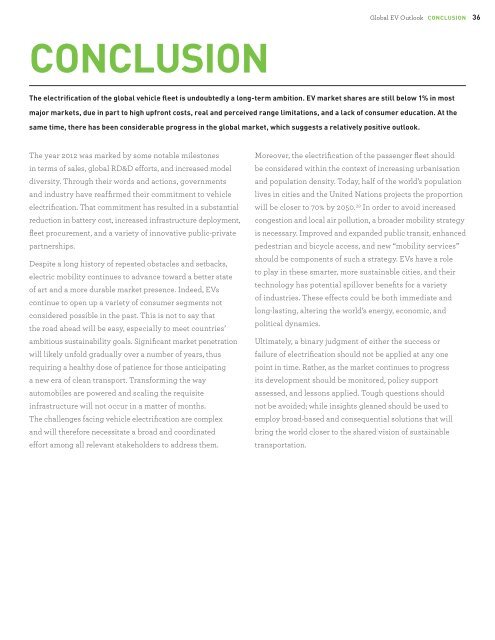Understanding the Electric Vehicle Landscape to 2020 - IEA
Understanding the Electric Vehicle Landscape to 2020 - IEA
Understanding the Electric Vehicle Landscape to 2020 - IEA
You also want an ePaper? Increase the reach of your titles
YUMPU automatically turns print PDFs into web optimized ePapers that Google loves.
Global EV Outlook CONCLUSION 36<br />
CONCLUSION<br />
The electrification of <strong>the</strong> global vehicle fleet is undoubtedly a long-term ambition. EV market shares are still below 1% in most<br />
major markets, due in part <strong>to</strong> high upfront costs, real and perceived range limitations, and a lack of consumer education. At <strong>the</strong><br />
same time, <strong>the</strong>re has been considerable progress in <strong>the</strong> global market, which suggests a relatively positive outlook.<br />
The year 2012 was marked by some notable miles<strong>to</strong>nes<br />
in terms of sales, global RD&D efforts, and increased model<br />
diversity. Through <strong>the</strong>ir words and actions, governments<br />
and industry have reaffirmed <strong>the</strong>ir commitment <strong>to</strong> vehicle<br />
electrification. That commitment has resulted in a substantial<br />
reduction in battery cost, increased infrastructure deployment,<br />
fleet procurement, and a variety of innovative public-private<br />
partnerships.<br />
Despite a long his<strong>to</strong>ry of repeated obstacles and setbacks,<br />
electric mobility continues <strong>to</strong> advance <strong>to</strong>ward a better state<br />
of art and a more durable market presence. Indeed, EVs<br />
continue <strong>to</strong> open up a variety of consumer segments not<br />
considered possible in <strong>the</strong> past. This is not <strong>to</strong> say that<br />
<strong>the</strong> road ahead will be easy, especially <strong>to</strong> meet countries’<br />
ambitious sustainability goals. Significant market penetration<br />
will likely unfold gradually over a number of years, thus<br />
requiring a healthy dose of patience for those anticipating<br />
a new era of clean transport. Transforming <strong>the</strong> way<br />
au<strong>to</strong>mobiles are powered and scaling <strong>the</strong> requisite<br />
infrastructure will not occur in a matter of months.<br />
The challenges facing vehicle electrification are complex<br />
and will <strong>the</strong>refore necessitate a broad and coordinated<br />
effort among all relevant stakeholders <strong>to</strong> address <strong>the</strong>m.<br />
Moreover, <strong>the</strong> electrification of <strong>the</strong> passenger fleet should<br />
be considered within <strong>the</strong> context of increasing urbanisation<br />
and population density. Today, half of <strong>the</strong> world’s population<br />
lives in cities and <strong>the</strong> United Nations projects <strong>the</strong> proportion<br />
will be closer <strong>to</strong> 70% by 2050. 39 In order <strong>to</strong> avoid increased<br />
congestion and local air pollution, a broader mobility strategy<br />
is necessary. Improved and expanded public transit, enhanced<br />
pedestrian and bicycle access, and new “mobility services”<br />
should be components of such a strategy. EVs have a role<br />
<strong>to</strong> play in <strong>the</strong>se smarter, more sustainable cities, and <strong>the</strong>ir<br />
technology has potential spillover benefits for a variety<br />
of industries. These effects could be both immediate and<br />
long-lasting, altering <strong>the</strong> world’s energy, economic, and<br />
political dynamics.<br />
Ultimately, a binary judgment of ei<strong>the</strong>r <strong>the</strong> success or<br />
failure of electrification should not be applied at any one<br />
point in time. Ra<strong>the</strong>r, as <strong>the</strong> market continues <strong>to</strong> progress<br />
its development should be moni<strong>to</strong>red, policy support<br />
assessed, and lessons applied. Tough questions should<br />
not be avoided; while insights gleaned should be used <strong>to</strong><br />
employ broad-based and consequential solutions that will<br />
bring <strong>the</strong> world closer <strong>to</strong> <strong>the</strong> shared vision of sustainable<br />
transportation.
















